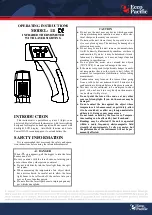
2.
To provide the user with more options, this unit o ffers 6 emissivity modes, including 0.99, 0.95,
0.89, 0.85, 0.79 and 0.75. Press the “Emissivity Selection” Button (Button
in the middle of the
panel) to select the mode sequentially. Each press results in a change in the emissivity mode. As
different objects have different emissivities, it is necessary to select the right emissivity setup to
ensure accurate measurement.
3.
To use
O
C/
O
F switch mode, open the cover of the battery holder and use the built- in switch
(which is at the upper part of the battery holder and visible as soon as the cover is removed) to
select the mode needed; to activate the laser aiming function, open the cover of the battery
holder and use the built- in switch to select the function needed (the laser is used for aiming
purpose only).
4.
To measure a temperature, point the unit at an object and pull the Scan Trigger. (Be sure to
consider distance-to-spot ration and field of view.) The temperature reading will appear on the
display. When the trigger is released, the unit will automatically store the last temperature
reading and turn off in about 15 seconds. Pressing the Scan Trigger again will restart the
scanning process.
5.
The unit provides MAX, MIN and AVG reading display functions. Press the button at the left of
the panel (Button M) to get the maximum, minimum and average readings measured.
VII
.
How to accurately measure the temperatures
1.
The unit gets temperature compensation automatically from the ambient temperature. After
measuring a high-temperature object, the unit needs at least 15 minutes to adapt to the
ambient temperature of the next object to be measured. In addition, it needs a few minutes
of preparation after measuring a low-temperature object and before measuring a
high-temperature object too.
2.
Locating a hot or cold spot: To find a hot or cold spot, aim the thermometer at the area of
interest. Then slowly scan across the area with up and down motions until you locate the
hot or cold spot.
3.
Field of view: Make sure that the target is larger than the unit’s spot size. The smaller the
target, the closer you should be to it. In cases where accuracy is of particular importance,
make sure that the target is at least twice as large as the spot size. When the laser aiming
function is activated, the laser spot indicates the area to be measured.
4.
How to use the AVG function: scan a number of spots in the measurement area of the object;
press the button at the left (Button M) and select AVG. The reading obtained is the average
value of the measurement, which is closer to the real temperature of the object.
VIII. Reminders
This product is designed for the measurement of surface temperatures of objects. If it is used
to mesure body temperatures, the results are for reference only. Any forehead temperature reading
within the range of 33
O
C~35
O
C is normal. The readings should be used for temperature
comparisons among individuals only, instead of as the basis of any medical activity. In the event of
any abnormal forehead temperature, please use a clinical thermometer to measure again. Make sure
that the laser function is turned off when using the product to measure the temperature of a human
body.
1.
Do not point the laser directly at the eyes of any people or animal, or at the surface of a polished
metal (e.g., stainless steel, aluminum) object.
2.
This thermometer cannot measure the temperature of an object through a transparent object, e.g.,























